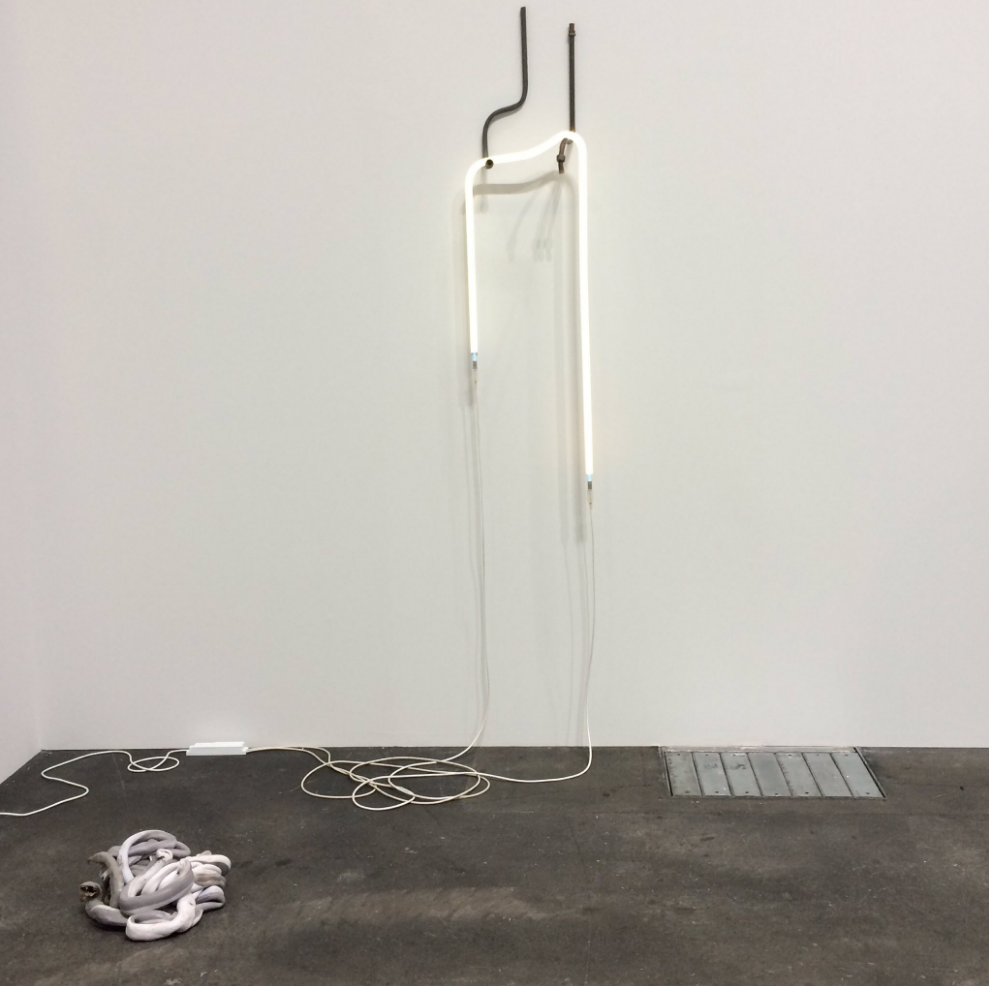Nina Canell presents Shedding Sheaths with Barbara Wien, Berlin, Daniel Marzona, Berlin and Mother’s Tankstation, Dublin, in Art Basel’s Unlimited sector. Unlimited is the fair’s platform dedicated to large-scale artists’ presentations, and is this year curated by New York-based curator Gianni Jetzer.
ArtReview You’re showing a version of your sculptural installation work Shedding Sheaths at Art Basel Unlimited, made using the discarded coils of plastic sheaths used to wrap fibre-optic cables. Can you tell us what ideas you were thinking about when you made this work?
Nina Canell I found the hollow fibre-optic sheaths as we were roaming the outskirts of Seoul in search of discarded cable-stumps from the subterranean undergrowth. The synthetic tangles were of instant interest and led to a continuation of my enquiry into the plasticity of contact and communication. Heated and compressed into space-efficient slabs or lumps these forms offer the cable as a fatigued container, vessel or corrupted body. An empty sensation is accentuated by the other parts of the installation that is comprised of a thin, stretched sine wave and a limp neon tube that has a weakened current passing through it. The infrastructure of energy that runs in and between solid objects as well as living things has been at the core of my work for the past decade. So as much as it was a sudden realisation and empathy for the collapsed fibre-optic sheaths, it was in fact preceded by years of work (involving cables both directly or not).
AR These objects could relate to an idea of growth and renewal – something that has shed its skin because it has outgrown it, how might that idea be relevant in the work for you?
NC Yes, I was interested in using the principle of shedding – small mounds that appear to have dropped to the ground like clothes or material leftovers of some kind of energy transaction. The regenerative nature of plastics and fuel of technological renewal was in there – yet cables are not simply technical systems embedded in the environment but also places where capital, labour and knowledge have been sunk into the Earth’s surface. Apart from that I’m interested in how the transformation of physical relations into dematerialised signals of exchange might preempt an even more immaterial (and less obviously communicational) form of non-verbal, perhaps telepathic, energy exchange.
AR Distance and nearness, the void, connectivity and invisible energy have been important elements within your work, and also seem encapsulated here. Can you expand on some of the meanings behind your interest in these ideas?
NC I have often tried to approach the relationship between the material and immaterial through sculpture as an agent or condition – it has this potential of articulating the fluctuations between things – a kind of glue. In relation to cable networks I think of them as hosts that modulate content, a medium with a transformative inevitability. An output is never the pure transmission of a source, but always as much the distance it has travelled and the things it has come in contact with (this is as true for words uttered vocally in between rooms as it is for long-distance word relay through conductive metals). This impurity can perhaps be described as a sculptural consistency, at times imperceptible and at times palpable, a signal loss that articulates the material something has travelled through. I am interested in that consistency and how it can be traced, stored and shared. In this context it might be worth mentioning a work I made during 12 calendar months in 2009-2010 whereby I synchronised a blackout each month in ten geographically disparate households by way of an unannounced remote signal. Ten individuals in different places came together by sharing a dissolved state – an interruption that came about through the temporary cut of an infra-structural constancy.
AR What does it mean to show this work within the specific context of an international art fair, and what effect might its location have on its perceived meaning?
NC The nature of the work definitely rings true in a different way within the oversaturated environs of an art fair! One can’t help but wonder about the circularity of things within this context, and the transfers that might have once been insulated by these sheaths. Since it is a relatively quiet and sparse installation I hope it will be able to strike a chord rather than emphasise the energy it takes to experience so many artworks and transactions in such a close proximity to one another.
AR Can you tell us something about what the focus of your next new project will be and what is exciting you most about it?
I’m working on a small kinetic sculpture that stores a rudimentary movement: a kind of repetitive, miniature muscle that is activated by heat.
Read more Art Basel questionnaires
Online exclusive published on 14 June 2016.
